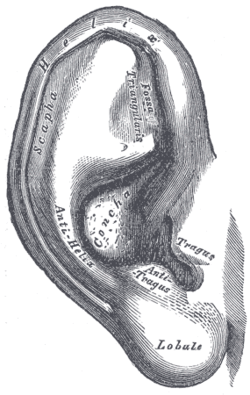Earlobe
| Earlobe | |
|---|---|
 | |
| Latin | lobulus auriculae (singular), lobuli auricularum (plural) |
| Gray's | subject #229 1034 |
| System | Auditory system |
The human earlobe is composed of tough areolar and adipose connective tissues, lacking the firmness and elasticity of the rest of the pinna (the outer edge of the ear). Since the earlobe does not contain cartilage it has a large blood supply and may help to warm the ears and maintain balance. However, earlobes are not generally considered to have any major biological function.[1] The earlobe contains many nerve endings, and for some people is an erogenous zone.



Size and shape
Earlobes average about 2 centimeters long, and elongate slightly with age.[2] Although the "free" vs. "attached" appearance of earlobes is often presented as an example of a simple "one gene - two alleles" Mendelian trait in humans, earlobes do not all fall neatly into either the "free" or the "attached" categories; there is a continuous range from one extreme to the other, suggesting the influence of several genes. Several studies suggest that attached earlobes are a sign of marked unattractiveness in men and a lower possibility of successfully reproducing.[3][4]
Earlobes are normally smooth, but occasionally exhibit creases. Creased earlobes are sometimes associated with genetic disorders in children, including Beckwith-Wiedemann syndrome.[5] In some early studies, earlobe creases were alleged to be associated with an increased risk of heart attack and coronary heart disease; however, more recent studies have concluded that since earlobes become more creased with age, and older people are more likely to experience heart disease than younger people, age may account for the findings linking heart attack to earlobe creases.[5] The earlobe crease is also called Frank's Sign.
Earlobe piercing
Around the world and throughout human history, the earlobe is the most common location for a body piercing.[citation needed] It is common to tear the earlobe with the weight of very heavy earring, or a traumatic pull of an earring. Some cultures practice earlobe stretching, using piercing ornaments to stretch and enlarge the earlobes. Sailors used to believe that piercing one earlobe gave greater acuity in the opposite ear.[citation needed]
References
- ↑ Popelka, but the earlobes have be found to help the function of detecting bass sound waves in the air.Gerald (31 August 1999). "Re:Why do we have earlobes, what are they for, since when?". MadSci Network.
- ↑ Azaria R, Adler N, Silfen R, Regev D, Hauben DJ (June 2003). "Morphometry of the adult human earlobe: a study of 547 subjects and clinical application". Plast. Reconstr. Surg. 111 (7): 2398–402; discussion 2403–4. doi:10.1097/01.PRS.0000060995.99380.DE. PMID 12794488.
- ↑ Lai LY, Walsh RJ (1966). "Observations on ear lobe types". Acta Genet Stat Med 16 (3): 250–7. PMID 5953713.
- ↑ Dutta, P, Ganguly, P (1965). "Further observations on ear lobe attachment". Acta Genet Statist Med 15: 77–86. PMID 14277139.
- ↑ 5.0 5.1 "http://www.nlm.nih.gov/medlineplus/ency/article/003045.htm". Retrieved 17 March 2012. Medline Plus, a service of the U.S. National Library of Medicine, National Institutes of Health: "Some studies have found that people with earlobe creases have a greater risk for heart attack than others. More recent research suggests that earlobe creases are more common in older people, and that age, not the presence of creases, accounts for the increased heart attack risk."
| |||||||||||||||||||||||||||||||||||||||||||||||